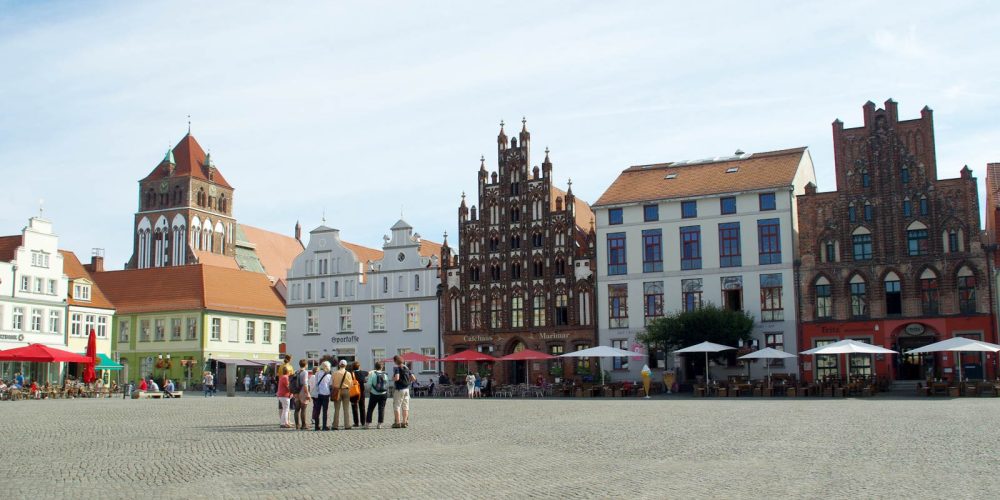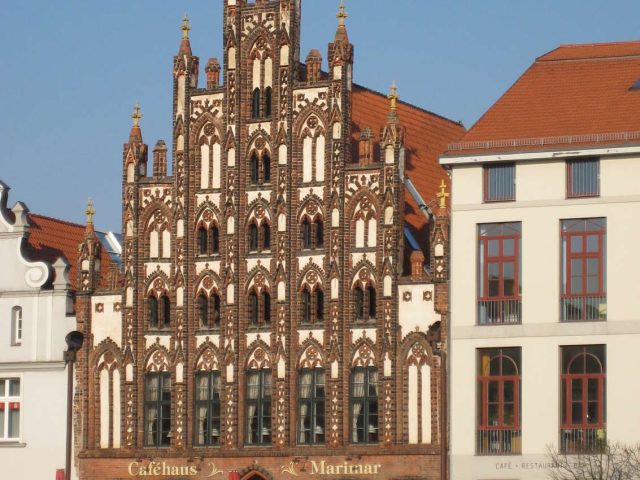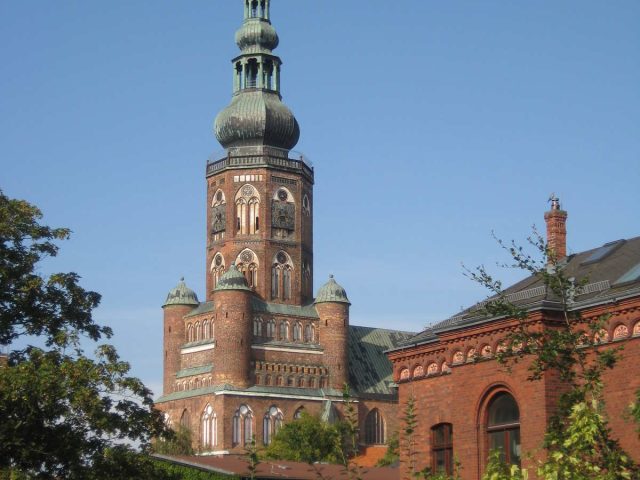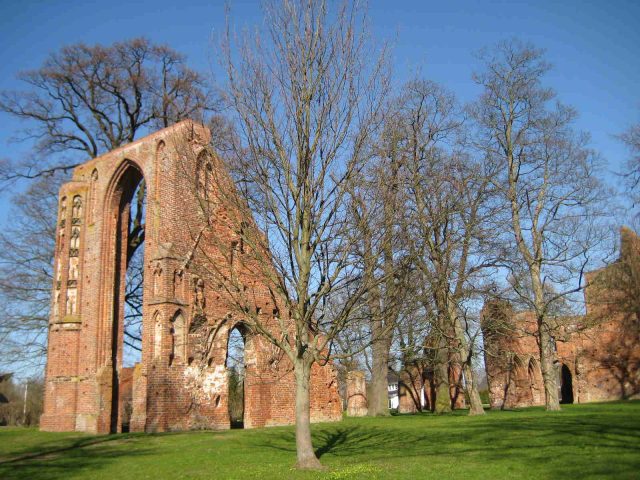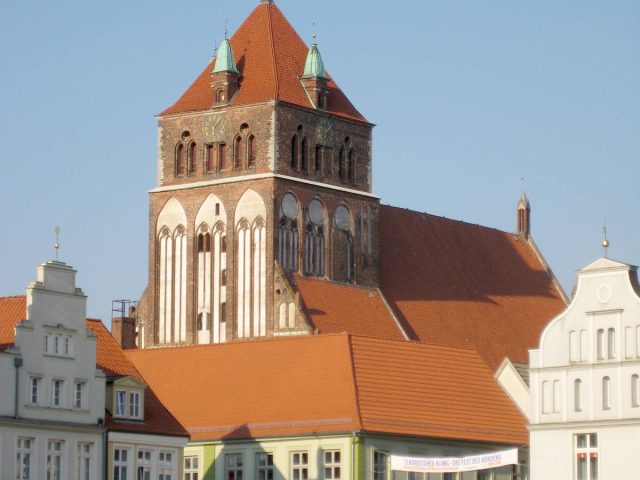The university and Hanseatic city of Greifswald is a city with maritime charm close to the Bay of Greifswald (Greifswalder Bodden), between the islands of Rügen and Usedom. Alongside the Hanseatic League, the founding of the university in 1456 contributed significantly to its development and still does today. Greifswald gained worldwide fame through the paintings of Caspar David Friedrich, one of the most important painters of the Romantic period. He made the Eldena monastery ruins a central motif of his work.
Greifswald
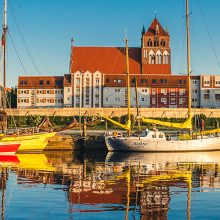
10 Years of the European Route of Brick Gothic Association
For two and a half days, members of the “European Route of Brick Gothic” Association celebrated its 10th anniversary in Greifswald – the place where the Association was founded 10 years ago. Over the course of two days – from 24 to 26 September 2017 – guests attending the celebrations in Greifswald were given a night watchman tour and detailed guided tours of St. Nikolai Cathedral and the Marienkirche. On 25 September 2017, a ship took attendees to the monastery ruin of Eldena in the nearby fishing village of Wieck. In the evening, guests from the worlds of politics and tourism joined the festivities in the beautiful setting of the Pomeranian State Museum. On foundation day, 26 September 2017, the Association held its Annual General Meeting, summarised the successes of the past 10 years and looked ahead to the coming year. For ten years, the Association has been working hand-in-hand with monument conservators and tourism experts to successfully preserve Brick Gothic’s cultural heritage. The German Foundation for Monument Conservation (Deutschen Stiftung Denkmalschutz) first drew attention to this special architectural style in the 1990s through its local initiative “On The Trail of Brick Gothic” (Wege zur Backsteingotik), which focused on northern […]
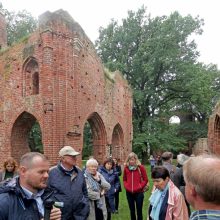
10 Jahre Europäische Route der Backsteingotik e. V. *
Zweieinhalb Tage lang begingen Mitglieder des Vereins “Europäische Route der Backsteingotik e. V.” seinen 10-jährigen Geburtstag in Greifswald – dem Ort, an dem der Verein vor 10 Jahren gegründet wurde. Vom 24. bis 26. September 2017 lernten die Teilnehmer der Feierlichkeit Greifswald bei einer Nachtwächterführung sowie detaillierten Führungen im Dom St. Nikolai und der Marienkirche besser kennen. Per Schiff ging es am 25. September 2017 zudem zur Klosterruine Eldena ins nahegelegene Fischerdorf Wieck. Abends wurde mit Gästen aus Politik und Tourismus im schönen Ambiente des Pommerschen Landesmuseums gefeiert. Am Gründungstag, dem 26. September 2017, hielt der Verein seine jährliche Mitgliederversammlung ab, rekapitulierte die erfolgreichen letzten 10 Jahre und gab einen Ausblick ins kommende Jahr. Seit nunmehr zehn Jahren arbeiten im Verein sehr erfolgreich Denkmalpfleger und Touristiker Hand-in-Hand, um das Kulturerbe Backsteingotik zu erhalten. Den Blick auf diesen besonderen Baustil lenkte zunächst die Deutschen Stiftung Denkmalschutz in den 1990er Jahren mit ihrer lokal auf Norddeutschland begrenzten Initiative „Wege zur Backsteingotik“. Dieser Initiative folgte das EU-Projekt „Europäische Route der Backsteingotik (EuRoB)“ von 2002 bis 2007. An diesem Projekt nahmen Städte rund um die ganze Ostsee bis ins Baltikum und Schweden teil. Im Anschluss an das EU-Projekt gründet sich der Verein am 26. […]
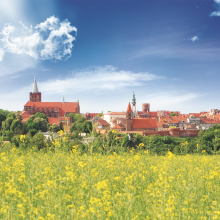
The story of the European Route of Brick Gothic
European Route of Brick Gothic: Attractive heritage of regions and cities Bricks are everywhere in the Baltic Sea region. They are historical witnesses of the middle ages in northern European coastal countries. This authenticity and the common architectural language associated with medieval brick buildings are the focus of the association European Route of Brick Gothic (EuRoB). EuRoB began as a project funded by Interreg back in 2002. Today it is a cultural route of 1500 km along the Baltic Sea coast. The technique of baking red bricks was brought to the Baltic Sea region from Italy in the 12th century. This novelty was a bliss to northern European countries where commonly used building material such as stone and timber were running low. This technique was distributed among some 200 towns of the Hanseatic League. Gradually, baked bricks became the prevailing building material and townscapes along the Baltic Sea flourished in different shades of red. As these buildings visually share characteristics widespread in other styles of Gothic architecture, the new style was called Brick Gothic. Roots of the Route The idea for the European Route of Brick Gothic originates from Professor Gottfried Kiesow, known for his substantial contributions to monument conservation […]
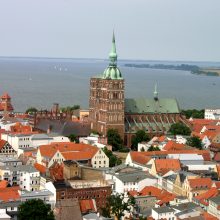
Att baka katedraler
Photo: Stralsund, Town Hall and St. Nikolai © Tourismuszentrale Stralsund ”Förhoppning” heter en en dikt av Edith Södergran, ur Septemberlyran (1918). Den hör till hennes mest älskade och det är lätt att förstå varför. Bildspråket är djärvt. Här kavlas ärmar upp för att av diktens jäsande deg knåda till något stort. ”Innan jag dör / bakar jag en katedral.” Det är bland annat det djärva kastet mellan förhoppning och förvissning som gör det. Katedral ska det bli. Här är ett diktjag som har upptäckt sina dimensioner. Men hur upptäckte hon bilden? Katedralbakning är inte någon känd syssla. Eller kanske ändå. Södergran kan ha tagit tyskan tilll hjälp. Det gör hon rätt ofta, i ordval, syntax, grammatik. Någon gång stjälper det mer än det hjälper. Någon gång blir det mera drastiskt på det viset, som när jaget i en dikt ligger inte på magen utan på buken. Så gör man på tyska. Södergrans ”Förhoppning” följde mig på vägen när jag nyligen körde längs Tysklands numera inte så långa östersjökust, från Lübeck till Usedom. Inte minst tack vare Hansans under flera sekler expansiva ekonomi kantas kusten av ett rart pärlband av burget byggda medeltida rödtegelkyrkor. De lanserar sig lite olika. En är […]
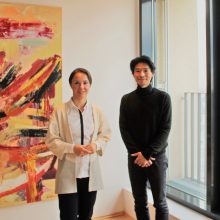
Visit from Japan
We are very pleased that Prof. Dr. Tadashi Saito, Professor of architecture and architectural history from Tokyo/Japan, visited us at our office in Berlin. He is not only dedicated to the research of architectural monuments, but also very interested in cultural tourism. We had a conversation with him about our work and received this great feedback: „Thank you very much for the opportunity that I was able to greet you personally yesterday in your wonderful office. I was so moved that you told me so passionately but also in detail, and of course with great pride, the story and all the experiences connected with Brick Gothic activities.“
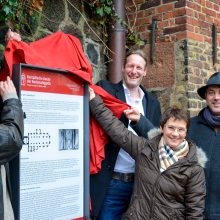
New information boards unveiled at 5 cultural monuments in Flensburg
Photo, from left to right: Monument curator and European Route of Brick Gothic Association board member Eiko Wenzel, Tourism Manager Gorm Casper (from the Flensburger Förde tourism agency), Pastor Sylvia Fuchs from St. Mary’s, Pastor Dr Marcus Friedrich from St. Nikolai Cathedral. The information boards in the design of the European Route of Brick Gothic were unveiled in front of the Nikolai Church. On the right, you can see the typical polychrome brickwork of the southern vestibule of St. Nikolai, built at the beginning of the 15th century according to models from the Lübisch-Mecklenburg area. © Anja Pfaff Flensburg, 27 December 2018 The new year is just around the corner and with it comes a great number of tourists visiting Flensburg in 2019. But there’ll be something new for the locals as well as the tourists this year. Five information boards have been fitted on some of the city’s characteristic Brick Gothic buildings. Tourism Manager Gorm Casper ceremoniously unveiled the information boards yesterday. Now, the public can read these boards and find out more about these typical medieval buildings at St. Nikolai Cathedral, St. Mary’s Church, St. John’s Church and the Church of the Holy Spirit as well as the […]
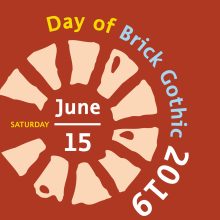
Day of Brick Gothic
On Saturday, June 15, 2019, is the Day of Brick Gothic! In Germany, Denmark and Poland, numerous members of the European Route of Brick Gothic invite to a special cultural program, like exhibition openings, exciting tours and exclusive insights into the subject of Brick Gothic. The 17 participating cities in 2019 are: Anklam, Bad Doberan, Burg Stargard, Chełmno (PL), Chorin, Frankfurt/Oder, Gdańsk (PL), Greifswald, Grudziądz (PL), Güstrow, Lübeck, Lüneburg, Olsztyn (PL), Płock (PL), Prenzlau, Roskilde (DK) and Wolgast. Program (will be updated regularly): Anklam: Click here for the program (in German) Bad Doberan: Das Münster ist geöffnet von 9-18 Uhr 10-18 Uhr Doberaner Klostermarkt Führungen: 11:00 Uhr Münsterführung 11:00 Uhr Führung von Kindern für Kinder 12:00 Uhr Führung ins Dachgewölbe, Turm, Glocken 13:00 Uhr Führung Münster und Klostergelände 14:00 Uhr Münsterführung mit thematischem Schwerpunkt 15:00 Uhr Führung ins Dachgewölbe, Turm, Glocken 18:00 Uhr Konzert im Münster: „Ein Feuerwerk und Unvollendetes“. Orchesterwerke von Händel, Schubert und Haydn, Sinfonieorchester der Stephanuskirche Hamburg, Leitung: Georgij Munteanu. Eintritt frei, Spende erbeten. Burg Stargard: Burgbaumeisterführung mit dem Baumeister der Höhenburg Stargard zu Burg Stargard – Henricus de Wodensweg Um 11:00 Uhr, um 14:30 Uhr sowie um 15:30 Uhr Chełmno: “Obejmij gotyk” w Chełmnie podczas “Europejskiego […]
Logo
Our logo can be used free of charge for the illustration of editorial contributions on the European Route of Brick Gothic. Likewise, on request, you can use certain photos by crediting the relevant photographer and copyright information. Unless otherwise stated, the copyright lies with the European Route of Brick Gothic (EuRoB). For other purposes of use, we ask you to clarify potential cost and copyright issues in advance with us. Contact us: Europäische Route der Backsteingotik e. V. Dr. Edith Kowalski Email: info@eurob.org Tel.: +49 30 206 132 555
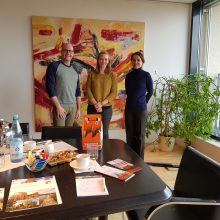
Monasteries on the European Route of Brick Gothic – Brick Gothic in the KLOSTERLAND
Many thanks to our cooperation partner KLOSTERLAND! „Monasteries on the European Route of Brick Gothic – Brick Gothic in the KLOSTERLAND?! This is both from the perspective of the European Route of Brick Gothic as well as the KLOSTERLAND an exciting topic that the two associations will tackle together from now on, as was decided in a small group today. Although the two organizations have been linked by mutual membership for several years, the meeting today was a small reboot. Last summer, KLOSTERLAND opted for a strategic reorientation towards #Kompetenzstelle for #Klosterkultur. Dr. Edith Kowalski took over the management of the #EuRoB office in May 2018. A mutual desire is to work more closely together in the future and implement concrete cooperation projects, such as travel offers, theme days / years or similar. We look forward to further cooperation and wish EuRoB and our cooperation a successful year 2019!“ Blog by Lara Buschmann and Stefan Beier

The Gothic in Gdańsk
On the 25th and 26th of April 2019, the city of Gdańsk in Poland celebrates the 10th anniversary of Gdańsk’s membership of the European Route of Brick Gothic, with many guests from monument preservation, science and tourism and an interesting cultural program (conference on the topic of Brick Gothic, outdoor exhibition and tour of Gdańsk). The conference takes place in the so called „Dwór Artusa“ and will be simultaneously translated into English. You can register for the conference via the registration form on visitgdansk.com (in English).
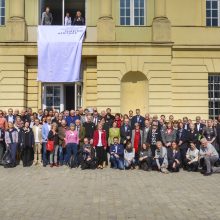
SHARING HERITAGE network meeting 2018 + 1
120 participants, 60 presentations and many dedicated ideas at the SHARING HERITAGE network meeting 2018 + 1 SHARING HERITAGE is a community about European cultural heritage, heritage preservation, monument protection, heritage education and Baukultur initiated by the German Cultural Heritage Committee (Deutsches Nationalkomitee für Denkmalschutz). Following up on the European Year of Cultural Heritage 2018, the community will continue SHARING HERITAGE in 2019. On April 2nd the SHARING HERITAGE community met in Schloss Charlottenburg in Berlin to present project results and to look back on the European Heritage Year of Cultural Heritage. In particular, the participation of young cultural heirs was identified as a common challenge. Most promoters or projects want to continue in 2019, so does the association European Route of Brick Gothic. The European Route of Brick Gothic also participated in the European Year of Cultural Heritage in 2018, which was celebrated throughout Europe under the motto “Sharing Heritage”, and on the occasion of the Heritage Year, launched the Brick Gothic Day. Also this year the Day of Brick Gothic will be celebrated again by numerous member cities in Denmark, Germany and Poland with various events around the topic of Brick Gothic. The German Cultural Heritage Committee thanks […]
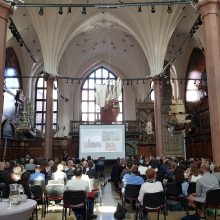
Anniversary Conference “Gothic in Gdańsk”
Brick Gothic in Gdańsk – Anniversary Conference on the occasion of the 10th anniversary of Gdańsk’s membership in the European Route of Brick Gothic [Text currently only in German and Polish] Zahlreiche Experten für gotische Ziegel kamen nach Danzig, die „Stadt der Freiheit, Solidarität und Backsteingotik“ – vor allem aus den Städten, die in der internationalen Vereinigung Europäische Route der Backsteingotik e.V. zusammengeschlossen sind, zu der unsere Stadt seit 10 Jahren gehört, aber nicht nur. Die zweitägige Konferenz (25. und 26. April 2019) im Danziger Artushof (Dwór Artusa) widmete sich dem gotischen Erbe nicht nur aus Sicht der Wissenschaftler, sondern auch als einzigartiges touristisches Produkt. Die Europäische Route der Backsteingotik ist ein internationales Kulturnetzwerk mit einer Bildungsmission, in dem derzeit 42 deutsche, dänische und polnische Städte zusammengeschlossen sind, in denen gotische Ziegel- bzw. Backsteindenkmäler bis heute erhalten sind. Eine der acht polnischen Städte des Vereins ist Danzig, auf dessen backsteingotischer Route sich unter anderem befinden: die Marienkirche („Bazylika Konkatedralna Najświętszej Marii Panny“, eine der größten Backsteinkirchen nördlich der Alpen), die Kirche des Hl. Nikolaus („Kościół św. Mikołaja“, die älteste Kirche in Danzig, gegründet im 12. Jahrhundert), die Große Mühle („Wielki Młyn“), das Krantor („Żuraw“), das Rathaus und viele mehr. An […]
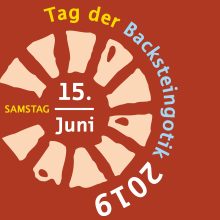
Day of Brick Gothic 2019
15 June 2019 is the Day of Brick Gothic! In Germany, Denmark and Poland, numerous members of the European Route of Brick Gothic invite the public on this day to enjoy special events, fascinating tours and exclusive insights. Several German, Polish and Danish cities along the European Route of Brick Gothic will celebrate the Day of Brick Gothic on Saturday, 15 June 2019, and present a diverse programme revolving around Brick Gothic. They will show which treasures their architecture has to offer, which ideas they have to get visitors interested in Brick Gothic and how they maintain and convey our cultural heritage. From exhibitions, concerts and special tours for children and adults, to exciting talks, discussions with experts or a varied family afternoon – the Day of Brick Gothic offers the right programme for every visitor. The history of the Middle Ages, the Hanseatic League and Brick Gothic is brought to life on this day. The member cities of the European Route of Brick Gothic combine the shared cultural heritage of Brick Gothic – the Medieval Brick Gothic architecture predominantly in the Baltic Sea region, which they aim to convey together to the general public. An important shared goal is […]
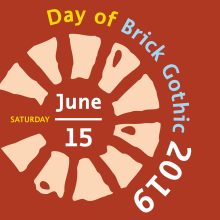
Day of Brick Gothic
On Saturday, June 15, numerous members of the European Route of Brick Gothic in Germany, Denmark and Poland celebrated the Day of Brick Gothic and invited to a special cultural program like exhibition openings, concerts, exciting tours and exclusive insights into the subject of Brick Gothic. The 18 participating cities in 2019 were: Anklam, Bad Doberan, Burg Stargard, Chełmno (PL), Chorin, Frankfurt/Oder, Gdańsk (PL), Greifswald, Grudziądz (PL), Güstrow, Lübeck, Lüneburg, Myślibórz (PL), Olsztyn (PL), Płock (PL), Prenzlau, Roskilde (DK) and Wolgast. We are looking forward to next year! The Day of Brick Gothic always takes place on the 3rd Saturday in June.
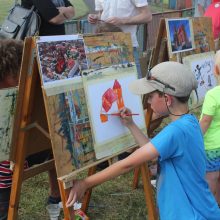
Day of Brick Gothic in Myślibórz
In order to confirm this year’s joining of Myślibórz to the European Route of Brick Gothic, various games and competitions have been organized under the motto “Myślibórz on the European Route of Brick Gothic” on June 15th, the Day of Brick Gothic. At the same time the “Festivities of Myślibórz” (“Dni Myśliborza”) were celebrated, of which the main organizer was the Cultural Center of Myślibórz (MOK Myśliborski Ośrodek Kultury). The Myślibórz Lake District Museum (Muzeum Pojezierza Myśliborskiego) organized an art competition for all interested children and the whole family. The main theme were the Brick Gothic monuments of Myślibórz, and together a model of the city with three-dimensional jewels of gothic architecture was build. The Municipal and District Library of Myślibórz also participated in the event. At the library stand a lottery was held, where knowledge of the history and the monuments of the town of Myślibórz was in demand. Special mention must be made of the fact that all the cultural institutions of the town of Myślibórz are housed in historic buildings dating back to the Middle Ages. text: Katarzyna Królak, Gmina Myślibórz photo: Alicja Schroeder
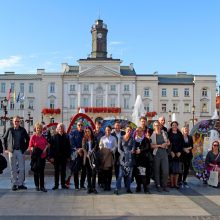
Brick Gothic group tours for the first time starting in 2020
Due to high demand, the association European Route of Brick Gothic offers group trips to the top Brick Gothic sights starting next year! The trips are organised in cooperation with the tour operator ReiseMission. The cooperation between the association and the tour operator begins with the group trip “Mecklenburg Brick Gothic in Six Days”, which will take place from 5 to 10 May 2020 leaving from Berlin. Registration for the group trip is possible as of now. For the time being, 12 Brick Gothic cities in Germany are involved; further cities and countries (Denmark, Poland) are to follow. The 12 participating cities in 2020 are: Bad Doberan, Burg Stargard, Bützow, Güstrow, Neubrandenburg, Neukloster, Parchim, Ribnitz-Damgarten, Rostock, Schwerin, Stralsund, Wismar. The highlight of each city tour is the Brick Gothic buildings and monuments, but visits also include museums, exhibitions and a brewery. The Leipzig tour operator ReiseMission is a specialist in educational group trips, aimed primarily at all those who are interested in religious and cultural history. Each group is accompanied by a professional tour guide and has the opportunity to participate in meetings and discussions with experts in church, culture and society. The managing director of the European Route of […]
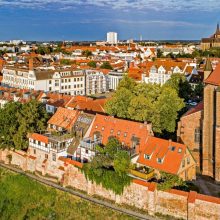
Rostock now a member of the European Route of Brick Gothic
Rostock, with its typical Brick Gothic architecture, was one of the most important Hanseatic cities in the Middle Ages alongside Lübeck and Wismar. It has now joined the Danish, German and Polish “European Route of Brick Gothic” network. With this membership, the Hanseatic university city of Rostock aims to make its many Brick Gothic architectural treasures in their cultural and historical context known throughout Europe. It is working with the association to foster awareness of their common cultural heritage of Brick Gothic among the general public. Before the association was founded in September 2007, when it was still in the project phase and financed by the EU, Rostock was already a partner of the European Route of Brick Gothic. Rostock’s new mayor, Claus Ruhe Madsen from Denmark, has chosen to breathe new life into this former successful collaboration. “We are united by a common history whose legacy lives on in various places on both sides of the Baltic Sea. What’s more, Rostock has many various places of interest to offer Danish and Polish tourists who wish to stay for longer visits – not just short stopovers”, says Claus Ruhe Madsen. Joint publishing efforts like the Culture Guidebook as well as […]
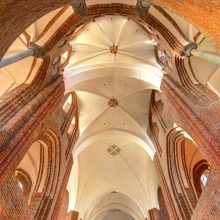
Glædelig jul
„In the calm and quiet twilight on the border between day and night the huge remains of past centuries still stand, and rise up in pointed arches and vaults as witnesses of earlier great past above the ailing present.“ Dear Friends and Supporters of Brick Gothic This saying by the 19th century painter Caspar David Friedrich is both remarkable and comforting. Remarkable, because it seems so current. Comforting, because our Brick Gothic buildings bear witness to numerous up and downs in the past. This crisis will also pass, even if it takes its toll on each of us in different ways. All the more important in these times are rays of hope and as many happy moments as possible. With this in mind, we wish you a Merry Christmas and a healthy start into the New Year. Cordial greetings with many thanks for the good cooperation from the EuRoB Managing Board and the Executive Director Christoph Pienkoß & Edith Kowalski
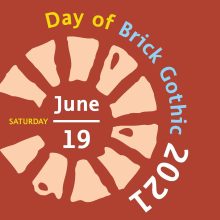
Day of Brick Gothic 2021
19 June 2021 is the Day of Brick Gothic! On this day, numerous members of the European Route of Brick Gothic invite the public to enjoy special events, fascinating tours and exclusive insights. The member cities of the European Route of Brick Gothic are united by the shared cultural heritage of Brick Gothic – the medieval brick architecture predominantly in the Baltic Sea region, which they aim to convey together to the general public. An important goal is to inspire people for conserving this cultural heritage. Participating cities and program 2021: See also Facebook and Instagram Anklam Have a look on June 19 on Facebook and Instagram Buxtehude Have a look on June 19 on Facebook and Instagram Flensburg Two lectures in St. Nicholas’ Church by Eiko Wenzel, curator of monuments in Flensburg: 16.00 | European Route of Brick Gothic. Building culture as an element that unites people 17.00 | St. Nicholas’ Church and Brick Gothic in Flensburg Afterwards: 17.30 | Architect Axel Gülstorff presents pending redevelopment measures Frankfurt (Oder) The St. Mary’s Church in Frankfurt (Oder) participates this year with a quiz. Gdańsk 19 June 2021 10.00 | Meeting point: Jan Heweliusz Monument in front of the Old Town […]
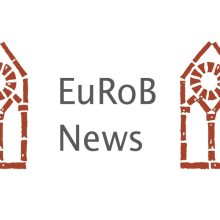
News at the beginning of the year
Dear Friends and Supporters of Brick Gothic At the beginning of 2021, we are starting a new challenging but also exciting year. Working group on monument preservation / science issues On February 24th, 2021 from 5 p.m., our working group on monument preservation / science issues will meet for an online session via Zoom. The topics include further steps towards a Brick Forum, the latest research results on St. George’s Chapel in Eberswalde and – to take a comparative look at other European countries – an inner brick wall from the 14th century in Italy. If you are interested in attending this meeting, please let me know and I will send you the access data for the meeting (only for members). Day of Brick Gothic 2021 We have started planning this year’s Day of Brick Gothic on June 19th, 2021. In addition to the flyer and poster templates, there will be a template specifically for images in social networks such as Instagram and Facebook. This enables us to promote the Day of Brick Gothic as a joint event, especially in the digital sector. The aim of this day is to draw attention to the cultural heritage of Brick Gothic and […]
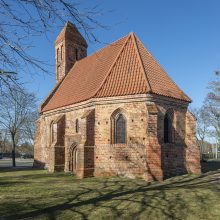
The Hospital Chapel of St. George in Eberswalde
The significance of Eberswalde grew considerably when Albrecht II made the town a place of power of the Brandenburg margrave. In addition to the representative development of the town church of St. Mary Magdalene, the administrative relocation of an important trade route via Eberswalde is indicative of the contents of a margravial document sealed in 1317. The increasing traffic on this road, which also passed the nearby Chorin monastery, eventually became an important basis for the foundation of St. George’s Hospital outside the gates of the town. The exact date of the foundation is unknown. The first mention of an altar in the leprosarium chapel of St. George was in 1359. In 1360, the altar received a further donation. By 1370, the chapel already enjoyed such good financial standing that it could provide money for the construction of the tower of the Eberswalde town church. There are also no written sources for the construction of the hospital chapel — today the only surviving building of the hospital. Friedrich Alder, a 19th century building archaeologist, dates this building to the middle of the 14th century because of its “simple and austere construction forms” and the “excellent technique”, an assessment shared by […]
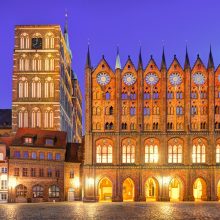
World Heritage and Brick
The 2021 annual edition of the magazine WELT-KULTUR-ERBE of the Hanseatic cities of Stralsund and Wismar with the thematic focus “World Heritage and Brick” is now available, with an article on the European Route of Brick Gothic (in German): Universeller Wert eines universellen Baumaterials – Das internationale Netzwerk Europäische Route der Backsteingotik e.V. (Universal value of a universal building material – The international network European Route of Brick Gothic) The magazine is available at the Stralsund Tourist Information Center.
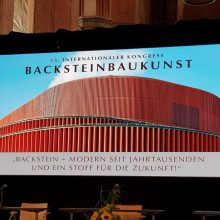
The Brick Gothic working group introduces itself
In September 2020, architectural historian Dirk Schumann and EuRoB Executive Director Dr. Edith Kowalski took part in the 15th International Congress of Brick Architecture in Wismar and presented her scientific working group on Brick Gothic, which is affiliated with the European Route of Brick Gothic. The conference proceedings were published in May 2021. You can find the contribution here (in German): Dr. Edith Kowalski / Dirk Schumann: “On the history of a universal building material – the Brick Gothic working group introduces itself”, in: “Brick Architecture – on monument culture in Europe”, Volume IX, Documentation of the 15th International Congress 2020 in Wismar.
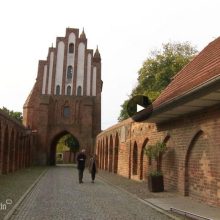
EuRoB on TV
On the occasion of our General Meeting 2021 in Neubrandenburg, North German television and radio (Norddeutscher Rundfunk, NDR) were on site and made a film for a TV magazine called “Nordmagazin”. The TV reportage can be found here.
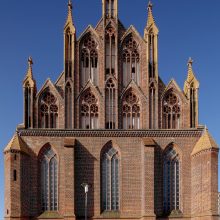
Travel report of a support member
As a support member I attended for the first time a general meeting of the European Route of Brick Gothic (EuRoB), driving from the Eifel to Neubrandenburg via Gotha, Bad Belzig in High Fläming, Potsdam and Buberow, then afterwards to Lübeck via Altentreptow, Burg Klempenow and Wismar. What a rich assortment of Gothic Brickwork! In High Fläming, Burg Eisenhardt is a 15C castle in Flemish bond (SHSH repeated every two courses; S = Stretcher i.e. brick laid lengthwise, H = Header i.e. the short side to the front) and even the Police Station just next door is in the same brickwork, unusual for a modern building. The brickwork used in the 18C Dutch quarter in Potsdam is in the more modern Cross bond (SHSH repeated every four courses), while the “brickwork” of the 18C New Palace is merely painted on! Thanks to Dirk Schumann we learned such a lot about the history of Neubrandenburg and also how to use the brickwork bonding to interpret the various phases of a building’s history: the 14C church of St Mary, now a concert hall, has the outer brickwork in Monk bond (SSHSSH) while what must be later, interior walls had brickwork in Flemish […]

Day of Brick Gothic 2022
June 18th, 2022 is the Day of Brick Gothic On this day, numerous members of the European Route of Brick Gothic invite the public to enjoy special events, fascinating tours and exclusive insights. > Press release on the Day of Brick Gothic 2022 Participating cities in 2022 (the program is constantly updated) Bad Doberan Guided and special tours in Doberan Minster: 11:00 Minster tour 12:00 Special guided tour of the monastery and minster 13:00 Guided tour of the vaulted ceiling, tower and bells with a view of the Baltic Sea 14:00 Minster tour 15:00 Guided tour of the vaulted ceiling, tower and bells with a view of the Baltic Sea 16:00 Minster tour The library in the convent hall of the minster and the ossuary are open exceptionally from 10 a.m. to 4 p.m., the minster from 10.30 a.m. to 5 p.m. Current information at: www.muenster-doberan.de Brandenburg/Havel On this day, attention is drawn to the Gothic House (“Gotisches Haus”) at Ritterstraße 86 in Brandenburg’s old town, one of the best-preserved and best-examined Gothic secular buildings in Brandenburg. There is a small exhibition in the basement that can be visited virtually, and visitors can also find out more about the archaeological […]
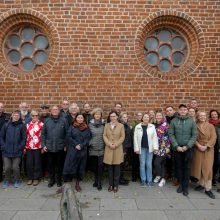
International guests visit the City of Four Gates Neubrandenburg
This year’s General Meeting of members of the European Route of Brick Gothic was held for the first time in the City of Four Gates Neubrandenburg. How did the visit come about? I vividly remember how — we made the commitment back at the General Meeting of members 2017 in Greifswald: “2020 in the City of Four Gates Neubrandenburg and Burg Stargard. We will be happy to see you there.” Well, that was the plan. But the measures to contain the coronavirus threw a spanner in the works. Still, better late than never. So, this year we made up for the General meeting we had missed out on, and Neubrandenburg and Burg Stargard’s Brick Gothic took centre stage for three days. Working closely with our former heritage conservator Marie Mamerow and Mr Saß from Burg Stargard, I had great pleasure in putting together the programme for the three-day General meeting. We had it all in the bag … well, not just proverbially — the souvenir gifts from the City of Four Gates were being just packed, and the event was about to begin. With great anticipation, I drove to the bus station on the 20th of October 2021, and I […]
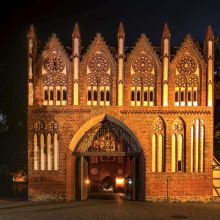
Christmas Greetings
Dear Friends and Supporters of Brick Gothic Christmas time and the start of a new year is often a time to reflect. We look back on our delightful encounters, and they remind us that together everything is so much easier to cope with. Together we can master all challenges, for only together are we truly strong. Community unites rather than divides, and our community helps us to achieve things we could hardly achieve alone. Together, we can reach out for so much more. Let us remember this at Christmas, and let us continue to support each other for our common success. With this in mind, we are looking forward to the coming year, when we will celebrate 15 years of European Route of Brick Gothic. We wish you all the very best, lots of positive energy, a peaceful Christmas and a healthy New Year! Our most cordial greetings and many thanks for all the good cooperation, the EuRoB Managing Board and the Executive Director Christoph Pienkoß & Dr. Edith Kowalski Photo: Treptow Gate, Neubrandenburg © Eiko Wenzel

How they made cathedrals out of bricks
We would like to take this opportunity to thank you for the lovely guidebooks you sent us. The members of our travel group were very pleased with them. In future, we hope to be able to interest more groups in the Brick Gothic. I am sending you a short travel report by our Univentra group leader to give you some information on our trip: The Meersburg Ecumenical Educational Association’s study trip to the UNESCO World Heritage Sites of the Hanseatic Brick Gothic Where natural stone is scarce, medieval builders developed a special Gothic building style, the Brick Gothic. Based on the rediscovered tradition of fired bricks, this development is closely linked to the history of the Hanseatic League. Strong economic ties also led to intensive cultural exchange with other countries. Around the middle of the 13th century, the French/Flemish style for building representative cathedral basilicas was adopted and, due to the lack of natural stone resources, a specific form of this Gothic style emerged, the Brick Gothic. St. Mary’s Church in Lübeck set the standard for this architectural type, and many of the basilicas in the Baltic region followed its example. It was therefore only logical that the 19 members […]
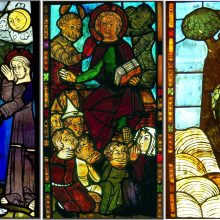
Apocalypse and Antichrist – the chancel windows of St. Mary’s Church in Frankfurt (Oder)
St. Mary’s Church in Frankfurt (Oder) ranks among the largest hall churches of Northern German Brick Gothic. For good reason, too, as visitors will perceive the exterior of the church as an imposing brick monument. Upon entering it, however, many visitors are surprised to find themselves in an empty nave. Before the Second World War, things were quite different: rich treasures of art still filled the church. Among its furnishings were a gold-crowned high altar (1489), a 4.70-metre-wide bronze baptismal font, a seven-branched candelabrum (both around 1376) and the stained glass of the three main chancel windows with biblical scenes and the story of the life and death of the Antichrist (around 1360), along with the pews, the pulpit, and the organ. While fire destroyed the latter in April 1945, the altar, the baptismal font and the candelabrum have found a new home with the Protestant congregation in St. Getrude’s Church. The fact that the valuable chancel windows still exist today is partly due to a decree on air-raid protection of cultural assets issued by the Reich Ministry of Science, Education and Culture in 1940. In late summer 1941, a Frankfurt glazier removed, disassembled and numbered the windows and then […]
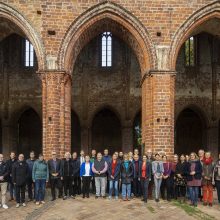
General meeting in Chorin and Eberswalde
In July 2017, the city of Eberswalde and Chorin Monastery joined the European Route of Brick Gothic association, a registered non-profit organization, together as a joint full member. Five years later, they hosted the 16th general meeting of the association. Splendid, late summer weather set the scene when a group of over 30 members from Germany and Poland met first in Chorin, then in Eberswalde. A rich cultural program went with the meeting, allowing the group to visit outstanding brick Gothic monuments and to exchange ideas with their specialist colleagues directly on site. In addition to Chorin Monastery, the focus was on St. Mary Magdalene’s Church in Eberswalde. The first two days were spent in Chorin. Globus Naturkost from Eberswalde took excellent care of the catering on the day of the general meeting. On the third day, the members travelled from Chorin to Eberswalde courtesy of a shuttle provided by Taxi Wutskowsky. “We are delighted that the mayor of Eberswalde, Götz Herrmann, found the time to welcome us in person. This is not a matter of course and means a lot to our association,” Dr. Edith Kowalski, Managing Director of the European Route of Brick Gothic, said. City planner Karen […]
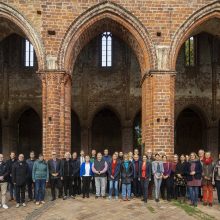
Celebrating 15 years of the European Route of Brick Gothic
This year, the association European Route of Brick Gothic marks its 15th anniversary. Over the years, its activities have inspired many people with enthusiasm for Brick Gothic. The international association is now a well-known organization in the entire Baltic Sea region. The association European Route of Brick Gothic was founded on 26 September 2007, born out of an initiative by the German Foundation for Monument Protection entitled “Routes to Brick Gothic”. The aim of the initiative was to raise awareness of this unique cultural landscape among the wider public. The European Route of Brick Gothic continues this important work on a transnational basis. Today, the route comprises around 60 members – towns and cities, municipalities, regions, and institutions in Denmark, Germany, and Poland – as well as numerous sponsors and cooperation partners. This brings together hundreds of Brick Gothic buildings around the Baltic Sea as well as further inland, in towns and in the countryside. The members work collectively to preserve the cultural heritage of Brick Gothic and to promote it to a broad public. “The European Route of Brick Gothic is a great example of how a funded project became a self-sustaining association,” says Christoph Pienkoß, chairman of the […]
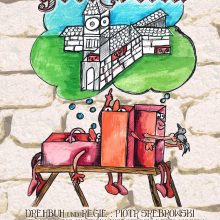
Theatre for children »Gothic for the little ones«
Can bricks be fun? And the Gothic architecture? Anything is possible in theatre! GotiKlein – Gothic for the little ones is a family theatre that combines the beauty of Gothic architecture with a sense of humor. The cultural spectacle can be seen as a theatre of forms, in which spectators of all ages will find something for their eyes and ears. The performance uses elements of puppet theatre, dance theatre, pantomime and commedia dell’arte. Surprising twists, innovative shapes and simplicity – that’s our recipe for just under an hour of fun! The performance will take place for the first time on October 1st and 3rd, 2022 at 3 p.m. in the nave of the Chorin Monastery on the occasion of the Herb and Ceramics Days. Tickets are also available there (Entry: 6,00 € / reduced 4,00 € | family card: 13,00 €). Theatre “Teatr Czwarte Miasto” in cooperation with the European Route of Brick Gothic. About the theatre: Teatr Czwarte Miasto was founded on May 16, 2013 by Polish actor and director Dariusz Majchrzak and theatre specialist Dorota Sadowska in Gdynia, a port city on the Baltic Sea coast. Teatr Czwarte Miasto is a young, dynamic and fast-growing foundation active […]

Theatre for children »Gothic for the little ones«
Can bricks be fun? And the Gothic architecture? Anything is possible in theatre! GotiKlein – Gothic for the little ones is a family theatre that combines the beauty of Gothic architecture with a sense of humor. The cultural spectacle can be seen as a theatre of forms, in which spectators of all ages will find something for their eyes and ears. The performance uses elements of puppet theatre, dance theatre, pantomime and commedia dell’arte. Surprising twists, innovative shapes and simplicity – that’s our recipe for just under an hour of fun! The performance will take place for the first time on October 1st and 3rd, 2022 at 3 p.m. in the nave of the Chorin Monastery on the occasion of the Herb and Ceramics Days. Tickets are also available there (Entry: 6,00 € / reduced 4,00 € | family card: 13,00 €). Theatre “Teatr Czwarte Miasto” in cooperation with the European Route of Brick Gothic. About the theatre: Teatr Czwarte Miasto was founded on May 16, 2013 by Polish actor and director Dariusz Majchrzak and theatre specialist Dorota Sadowska in Gdynia, a port city on the Baltic Sea coast. Teatr Czwarte Miasto is a young, dynamic and fast-growing foundation active […]
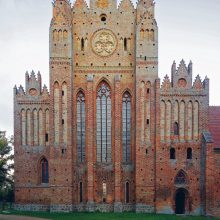
Merry Christmas!
“Coming together is a beginning, staying together is progress, working together is success.” Dear Friends and Supporters of Brick Gothic, This year saw the 15th anniversary of the founding of our association. Over the years, we have been able to inspire many people for the Brick Gothic. Together, we have opened this historic cultural landscape for cultural tourism from a heritage conservation perspective. Culture offers space for identity, creates understanding and a sense of connection. It makes us reflect and see opportunities, supplies inspiration and stores knowledge. Through culture, we can counter the crises of our time with meaning, joy, and resilience. We would like to thank you most warmly for the good cooperation and the confidence you have placed in our work. We wish you a merry and peaceful Christmas and a happy, healthy, and prosperous New Year. Managing Board and Executive Director of the European Route of Brick Gothic Photo: Chorin, Abbey church, western view © Eiko Wenzel Quote: Henry Ford
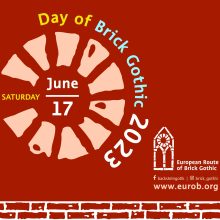
Day of Brick Gothic 2023
June 17th is the Day of Brick Gothic On this day, numerous members of the European Route of Brick Gothic invite the public to enjoy special events, fascinating tours and exclusive insights. Participating cities in 2023 (the program is constantly updated) Bad Doberan 11 am: Guided tour of the Minster 11 am: Tour “Children guiding children” 1 pm: Guided tour of the vaulted ceiling, tower and bells 2 pm: Guided tour of the Minster The Doberan Minster is open from 10 am – 5 pm. Buxtehude 11 am – 6 pm: Brick to touch in the Marschtorzwinger: At night all brick is gray… On the Day of Brick Gothic, you can see how diverse brick can be. Bricks from different centuries invite you to touch, compare, wonder. Experience the development from hand-formed to machine-produced brick. Meeting place: Marschtorzwinger Buxtehude, Westfleth, D-21614 Buxtehude Exhibition in the Marschtorzwinger: “Little harbor tour” by Jakobus Durstewitz Opening hours: Tuesday – Friday from 3 – 6 pm Saturday and Sunday from 11 am – 6 pm More info at Exhibitions in Buxtehude 2 pm: Public guided tour: Brick Gothic in Buxtehude In the Hanseatic city of Buxtehude there are several testimonies of Brick Gothic, which […]

Day of Brick Gothic 2023
June 17th is the Day of Brick Gothic On this day, numerous members of the European Route of Brick Gothic invite the public to enjoy special events, fascinating tours and exclusive insights. Participating cities in 2023 (the program is constantly updated) Bad Doberan 11 am: Guided tour of the Minster 11 am: Tour “Children guiding children” 1 pm: Guided tour of the vaulted ceiling, tower and bells 2 pm: Guided tour of the Minster The Doberan Minster is open from 10 am – 5 pm. Buxtehude 11 am – 6 pm: Brick to touch in the Marschtorzwinger: At night all brick is gray… On the Day of Brick Gothic, you can see how diverse brick can be. Bricks from different centuries invite you to touch, compare, wonder. Experience the development from hand-formed to machine-produced brick. Meeting place: Marschtorzwinger Buxtehude, Westfleth, D-21614 Buxtehude Exhibition in the Marschtorzwinger: “Little harbor tour” by Jakobus Durstewitz Opening hours: Tuesday – Friday from 3 – 6 pm Saturday and Sunday from 11 am – 6 pm More info at Exhibitions in Buxtehude 2 pm: Public guided tour: Brick Gothic in Buxtehude In the Hanseatic city of Buxtehude there are several testimonies of Brick Gothic, which […]
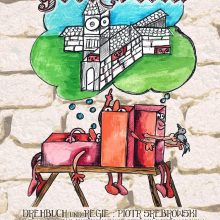
Theatre for children »Gothic for the little ones«
Can bricks be fun? And the Gothic architecture? Anything is possible in theatre! GotiKlein – Gothic for the little ones is a family theatre that combines the beauty of Gothic architecture with a sense of humor. The cultural spectacle can be seen as a theatre of forms, in which spectators of all ages will find something for their eyes and ears. The performance uses elements of puppet theatre, dance theatre, pantomime and commedia dell’arte. Surprising twists, innovative shapes and simplicity – that’s our recipe for just under an hour of fun! Theatre “Teatr Czwarte Miasto” in cooperation with the European Route of Brick Gothic. About the theatre: Teatr Czwarte Miasto was founded on May 16, 2013 by Polish actor and director Dariusz Majchrzak and theatre specialist Dorota Sadowska in Gdynia, a port city on the Baltic Sea coast. Teatr Czwarte Miasto is a young, dynamic and fast-growing foundation active on stages in Poland and internationally. “We present performances that touch on life’s current issues, that are fun, informative and reflective. During our activity we put on over 800 performances for children and adults in Poland and abroad – in Europe we visited countries such as Germany, Romania, Belgium, France, the […]
Theatre for children »Gothic for the little ones«
Can bricks be fun? And the Gothic architecture? Anything is possible in theatre! GotiKlein – Gothic for the little ones is a family theatre that combines the beauty of Gothic architecture with a sense of humor. The cultural spectacle can be seen as a theatre of forms, in which spectators of all ages will find something for their eyes and ears. The performance uses elements of puppet theatre, dance theatre, pantomime and commedia dell’arte. Surprising twists, innovative shapes and simplicity – that’s our recipe for just under an hour of fun! Theatre “Teatr Czwarte Miasto” in cooperation with the European Route of Brick Gothic. About the theatre: Teatr Czwarte Miasto was founded on May 16, 2013 by Polish actor and director Dariusz Majchrzak and theatre specialist Dorota Sadowska in Gdynia, a port city on the Baltic Sea coast. Teatr Czwarte Miasto is a young, dynamic and fast-growing foundation active on stages in Poland and internationally. “We present performances that touch on life’s current issues, that are fun, informative and reflective. During our activity we put on over 800 performances for children and adults in Poland and abroad – in Europe we visited countries such as Germany, Romania, Belgium, France, the […]
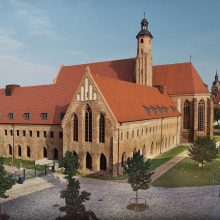
EuRoB in the specialist journal “Brandenburgische Denkmalpflege”
The current issue of the specialist journal “Brandenburgische Denkmalpflege” (Brandenburg Monument Preservation) contains an article on the European Route of Brick Gothic Association and its cross-border activities. Six Brandenburg sites are presented whose outstanding buildings belong to the route. The article “Communicating and preserving cultural heritage: The European Route of Brick Gothic” can be viewed here as PDF (in German) and purchased from Geymüller Verlag für Architektur (Geymüller Publishing House for Architecture).
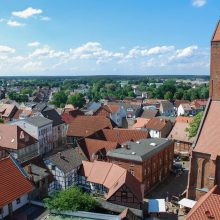
Pacesetters for the region: monuments as motors for the future
New article about the European Route of Brick Gothic in the current MONUMENTE publication of the German Foundation for Monument Protection (Deutsche Stiftung Denkmalschutz): „Pacesetters for the region: monuments as motors for the future“, available online at Monumente Online
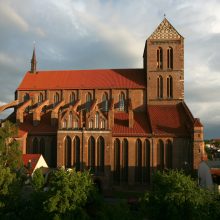
Brick Gothic architecture: top marketing of rich cities
In the magazine “daheim – Deutschlands schönste Seiten” (Home – Germany’s most beautiful places) an article about the churches and monasteries of the European Route of Brick Gothic was published. You can view the article “Stone on Stone: Travelling the Brick Gothic Route” as a PDF here.
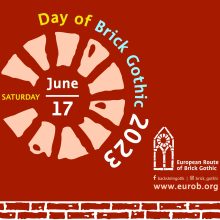
Bricks for all the senses – 17 June 2023 is Brick Gothic Day
Make a note of 17 June 2023, the Day of Brick Gothic. — Throughout this day, you can enjoy many special events, exciting guided tours and exclusive insights organised by numerous members of the European Route of Brick Gothic. On Saturday 17 June 2023, several German and Polish towns and cities along the European Route of Brick Gothic will celebrate the Day of Brick Gothic for the 6th time and offer a rich programme centred on medieval architecture made of brick. Their shared cultural heritage of Brick Gothic unites the member towns and cities, and they have joined forces to communicate this to the wider public. A key joint concern is to create a deeper understanding and appreciation of this cultural landscape and to inspire interest in its preservation. The Day of Brick Gothic is all about drawing attention to local Brick Gothic architecture. Themed events and activities help to raise awareness of Brick Gothic structures, especially among the local and regional population: There will be special guided tours for children and adults, exciting lectures, talks with experts or varied family afternoons to choose from. The Day of Brick Gothic has the perfect programme for every visitor. You can vividly […]
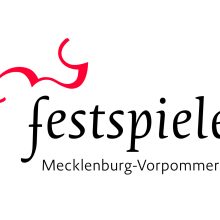
Guided tour
Brick Gothic guided tour (accompanying programme to the Mecklenburg-Vorpommern Festival 2023) 16:30 h Brick Gothic guided tour to the St. Mary’s Church (Konzertkirche Neubrandenburg) Meeting Point: St. Mary’s Church, Tower area, An d. Marienkirche, D-17033 Neubrandenburg Duration: 1 hour Admission: € 3 (limited capacity) More information at Eröffnungskonzert des Festspielsommers 2023 Pressemitteilung EuRoB

Guided tour
Brick Gothic guided tour (accompanying programme to the Mecklenburg-Vorpommern Festival 2023) 17:30 h Brick Gothic guided tour, Focus: Church of the Holy Spirit (Heiligen-Geist-Kirche) Meeting place: Church of the Holy Spirit, Lübsche Str. 46, D-23966 Wismar Duration: 1 hour Admission: € 3 (limited capacity) More information at Daniel Hope feat. New Century Orchestra Pressemitteilung EuRoB

Guided tour
Brick Gothic guided tour (accompanying programme to the Mecklenburg-Vorpommern Festival 2023) 17:30 h Brick Gothic guided tour, Focus: St. Nicholas Church (Nikolaikirche) Meeting place: St. Nicholas Church, Nikolaikirche 1, D-18055 Rostock Duration: 1 hour Admission: € 3 (limited capacity) More information at amarcord & Rostocker Motettenchor Pressemitteilung EuRoB

Guided tour
Brick Gothic guided tour (accompanying programme to the Mecklenburg-Vorpommern Festival 2023) 17:30 h Brick Gothic guided tour to the St. Mary’s Church (Konzertkirche Neubrandenburg) Meeting Point: St. Mary’s Church, Tower area, An d. Marienkirche, D-17033 Neubrandenburg Duration: 1 hour Admission: € 3 (limited capacity) More information at Eröffnungskonzert des Festspielsommers 2023 Pressemitteilung EuRoB

Guided tour
Brick Gothic guided tour (accompanying programme to the Mecklenburg-Vorpommern Festival 2023) 17:30 h Brick Gothic guided tour, Focus: St. Nicholas Cathedral (Dom St. Nikolai) Meeting place: St. Nicholas Cathedral, Domstraße 54, D-17489 Greifswald Duration: 1 hour Admission: € 3 (limited capacity) More information at amarcord & Rostocker Motettenchor Pressemitteilung EuRoB

EuRoB and Festspiele MV present joint guided tours
The European Route of Brick Gothic and Festspiele Mecklenburg-Vorpommern have started a cooperation to offer festival visitors a unique cultural experience. As part of this cooperation, exclusive guided tours of Brick Gothic buildings are offered before selected concerts, including the first and last concert in the festival programme. This will give visitors to the concerts first-hand experience of the Brick Gothic venues where the concerts will be held, so during the concerts they can reflect on what they have learned about the history and architecture of the buildings. “We are delighted to announce this cooperation with the festival organisers of Festspiele Mecklenburg-Vorpommern”, says Christoph Pienkoss, the chairman of the managing board of the European Route of Brick Gothic. “It is a wonderful opportunity to convey the beauty and importance of the Brick Gothic style to a wider audience and to help them immerse themselves in the rich cultural history of the region. We hope that these guided tours will give the visitors a deeper understanding of this unique architectural heritage and that they will be fascinated by the combination of music and history”. The guided tours will take place in the following Brick Gothic locations: Anklam (St. Mary’s Church), Bad […]
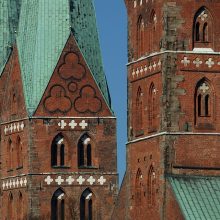
The European Route of Brick Gothic
In September 2022, the European Route of Brick Gothic Association, its history and activities were presented at the 17th International Congress of Brick Architecture in Wismar. The associated conference proceedings were published in May 2023. You can view the proceedings here (in German): Dr. Edith Kowalski: Die Europäische Route der Backsteingotik e. V., in: „Backsteinbaukunst – zur Denkmalkultur in Europa“, Band XI, Dokumentation des 17. Internationalen Kongresses 2022 in Wismar „Backstein – Vielfalt gebrannter Erde. Vom Dachziegel bis zur Terrakotta“ See also the website of the organization Europäisches Zentrum der Backsteinbaukunst e. V.
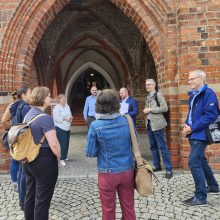
Meeting of the scientific working group in Jüterbog
On 25 July, the members of the scientific working group of the European Route of Brick Gothic met for academic discussions in Jüterbog. The participants included building and art historians, archaeologists and monument conservationists from the whole of Germany. The town of Jüterbog became a member of the European Route of Brick Gothic, which is a recognised non-profit association, in 2016. The meeting was admirably organised by Andreas Rau from the Jüterbog business promotion agency. After the event he commented that the scientific meeting had been a highly informative day. The participants were warmly welcomed by Christiane Lindner-Klopsch, the deputy mayor of the town. The director of Jüterbog’s museums, Norbert Jannek, provided support to the meeting and enabled the members to gain a thorough first hand impression of the outstanding Brick Gothic sights in the town and to exchange their views and experience with other specialists. The meeting began with a focus on the Brick Gothic buildings in Jüterbog, including the very well preserved mediaeval town hall, the former Franciscan monastery, which is now the “Mönchenkloster” cultural ensemble with an outstanding museum, and the richly decorated church of St. Nikolai. Even today the old sacristy, with its well preserved decorations, […]
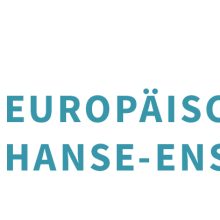
Brick Gothic guided tour – Hanse-Ensemble
Brick Gothic guided tour Accompanying programme to the concert “CELEBRATIONS – Music from the Life of the Old Hanseatic Cities” of the European Hanseatic Ensemble on Thursday, 19 October 2023 at St. John’s Church in Lüneburg 6.30 pm Brick Gothic guided tour of St. John’s Church (St. Johannis) in Lüneburg Meeting point: 6.30 pm in front of the entrance, St. Johanniskirche 2, D-21335 Lüneburg Duration: approx. 1 hour Admission is free Registration is requested under +49 30 2061325-55 or via email at info@eurob.org More information at: 19 October 2023: Lüneburg, St. John’s Church Concert tickets online at St. John’s Church Lüneburg
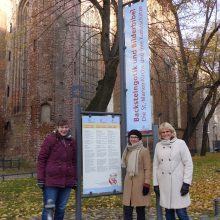
The first Brick Gothic information signs in front of Frankfurt’s Marienkirche (St. Mary’s Church)
The city of Frankfurt (Oder) has been a member of the association “European Route of Brick Gothic” (EuRoB) since 2012. Over the last decade, many travellers have come to Frankfurt (Oder) to visit St. Mary’s Church, one of the largest hall-type churches with north German Brick Gothic architecture. They have invariably carried a Brick Gothic travel guidebook, which is available for free in tourist information offices and other public offices. They have visited the church even though Frankfurt’s Brick Gothic architecture can now be enjoyed on virtual media. However, up to now there have not been any signs in the typical brick-red design which other cities and towns in the association use to provide guidance to tourists and culture enthusiasts who are following the route through northern Germany, Poland and Denmark. The two new information signs near the western portal of St. Mary’s Church are the first step in making Brick Gothic architecture and the network of the association visible in the urban context of the city. The location was a deliberate choice because it reactivates the former sign system on Regierungsstrasse after the outdated information signs were removed some time ago following an autumn storm. In future, visitors can […]
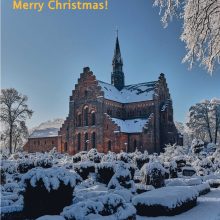
Merry Christmas
Dear Friends and Supporters of Brick Gothic We would like to thank you for our very positive collaboration this year. Together, we have succeeded in strengthening the significance of the Brick Gothic heritage, especially by combining Brick Gothic architecture with music and theatre. In the coming year we will continue and expand these cooperative projects. There will be interesting meetings of the working groups for science/brick architecture and marketing/tourism; a joint Brick Gothic stand is planned at the International Hanseatic Days. Another major focus will be on presenting Brick Gothic architecture to children and young people. We are looking forward to implementing these projects together with you. We wish you an enjoyable Christmas season and a healthy start into the New Year. Our most cordial greetings the EuRoB Managing Board and the Executive Director Løgumkloster Church © Colin John Seymour
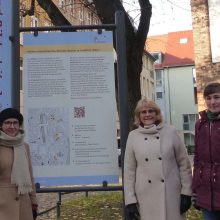
The first Brick Gothic information signs in front of Frankfurt’s Marienkirche (St. Mary’s Church)
The city of Frankfurt (Oder) has been a member of the association “European Route of Brick Gothic” (EuRoB) since 2012. Over the last decade, many travellers have come to Frankfurt (Oder) to visit St. Mary’s Church, one of the largest hall-type churches with north German Brick Gothic architecture. They have invariably carried a Brick Gothic travel guidebook, which is available for free in tourist information offices and other public offices. They have visited the church even though Frankfurt’s Brick Gothic architecture can now be enjoyed on virtual media. However, up to now there have not been any signs in the typical brick-red design which other cities and towns in the association use to provide guidance to tourists and culture enthusiasts who are following the route through northern Germany, Poland and Denmark. The two new information signs near the western portal of St. Mary’s Church are the first step in making Brick Gothic architecture and the network of the association visible in the urban context of the city. The location was a deliberate choice because it reactivates the former sign system on Regierungsstrasse after the outdated information signs were removed some time ago following an autumn storm. In future, visitors can […]

Guided tour
Brick Gothic guided tour (accompanying programme to the Mecklenburg-Vorpommern Festival 2024) 16:30 h Brick Gothic guided tour through the old town of Wismar Meeting Point: St.-Georgen, St.-Georgen-Kirchhof 1A, D-23966 Wismar Duration: 1 hour Admission: € 3 (limited capacity) More information at Eröffnungskonzert des Festspielsommers 2024

Guided tour
Brick Gothic guided tour (accompanying programme to the Mecklenburg-Vorpommern Festival 2024) 15:30 h Brick Gothic guided tour through the old town of Wismar Meeting Point: St.-Georgen, St.-Georgen-Kirchhof 1A, D-23966 Wismar Duration: 1 hour Admission: € 3 (limited capacity) More information at MV singt: Beethovens Neunte

Guided tour
Brick Gothic guided tour (accompanying programme to the Mecklenburg-Vorpommern Festival 2024) 17:30 h Brick Gothic guided tour of St. Mary’s Church (Konzertkirche) Meeting Point: St.-Marien-Kirche (Konzertkirche), Tower area, An d. Marienkirche, D-17033 Neubrandenburg Duration: 1 hour Admission: € 3 (limited capacity) More information at Kit Armstrong spielt Bach
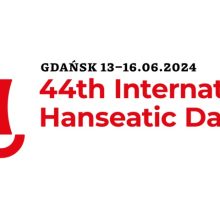
44th International Hanseatic Day
From June 13-16, 2024, the European Route of Brick Gothic will take part in the International Hanseatic Days in Gdansk. For more information see 44th International Hanseatic Day
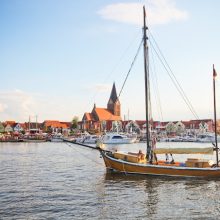
Barth is now a member of the European Route of Brick Gothic
Barth, which is a small town with Brick Gothic architecture and was apparently a major trading centre in the Middle Ages, has now joined the Danish/German/Polish network of the “European Route of Brick Gothic”. With its membership, the Vineta town of Barth intents to present its many Brick Gothic buildings in their important architectural and historical context as cultural monuments to visitors from all over Europe. The network and the town will now pool their resources to create greater public awareness of the common cultural heritage of Brick Gothic architecture. It is hoped that membership of the association will help visitors to focus on the Brick Gothic buildings in the town, so that they will be a magnet for cultural sightseeing as part of a short holiday in the recognised health resort of Barth. The European Route of Brick Gothic offers expertise, cultural tourism connections and support for this purpose. “Since 2015, Barth has been recognised as a state-approved health resort, and it is surrounded by natural scenic treasures which are familiar to all visitors to the Darss region. Our cultural history goes back much further, but Barth is not yet sufficiently known as a town of culture. That is […]
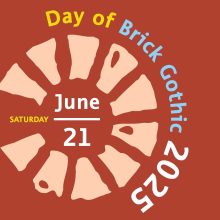
Day of Brick Gothic 2025
June 21, 2025 is the Day of Brick Gothic On this day, numerous members of the European Route of Brick Gothic invite the public to enjoy special events, fascinating tours and exclusive insights. Participating cities in 2025 (the program is constantly updated) Brandenburg an der Havel 10.30 to 11.30 am: Tour of the old town Meeting point: Fritze-Bollmann-Brunnen, Hauptstraße 22, D-14776 Brandenburg an der Havel Price per person: EUR 8.00, children up to 12 years free 12.00 to 12.30 pm: Organ music for lunch Meeting point: St. Catherine’s Church (St. Katharinenkirche), Katharinenkirchplatz Price per person: free, donations are requested Frankfurt (Oder) 6.00 pm: free guided tour on the subject of ‘St Mary’s in the 17th century’ before the concert by the European Hanseatic Ensemble at 7.00 pm On Saturday, 21 June 2025, the 8th Day of Brick Gothic, you can experience a journey through the musical culture of the trading metropolises of the early 17th century at 7 pm in St. Mary’s Church in Frankfurt (Oder). The European Hanseatic Ensemble under the direction of Manfred Cordes will present magnificent vocal-instrumental compositions from Hamburg, Stralsund, Szczecin and Gdansk, among others, in the sound of the early Baroque period as part of […]

General Meeting 2025
The 19th General Meeting of the European Route of Brick Gothic will take place September 17-19, 2025 in Grudziądz.
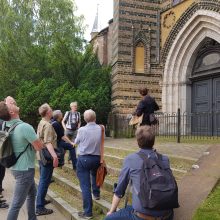
Meeting of the scientific working group
The next meeting of the working group on monument preservation / science issues will take place on Wednesday 26 March 2025 from 17.00 to 20.00 at our office.
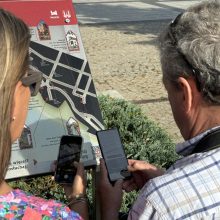
New signage in Płock
Nine EuRoB signs in the city of Płock have been replaced with modern, updated signs. Visitors can now find a general overview board at the Old Market Square, right next to the tourist information centre. In addition, eight further signs have been attached to the respective Brick Gothic buildings. There is also a special new feature: each sign has a QR code that leads to short audio clips with exciting information about the buildings. No app needs to be installed for this. You can find photos of the new signs on Facebook and Instagram.
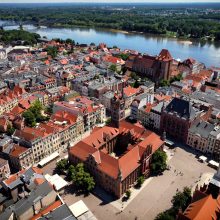
Toruń rejoins the European Route of Brick Gothic
The city of Toruń is rejoining the association “European Route of Brick Gothic,” based in Berlin, after an absence of 11 years. Toruń, one of the most important historic cities in Central Europe, boasts an extraordinary architectural heritage, the core of which is formed by excellently preserved Brick Gothic monuments. The historic city center is a UNESCO World Heritage Site and is regarded as one of the most valuable testimonies of medieval architecture in Europe. Toruń impresses with its outstanding Brick Gothic buildings. Among the most notable are St. Mary’s Church, St. James’s Church (Kościół św. Jakuba), the Old Town Hall, numerous patrician houses on the historic market square, as well as the well-preserved city walls with gates and towers. The birthplace of Nicolaus Copernicus also bears witness to the rich medieval history of the Hanseatic city. These unique examples of North German Brick Gothic make Toruń an indispensable member of the European Route of Brick Gothic. In April 2025, the Toruń City Council unanimously approved the city’s rejoining of the association; in September, approval followed from the Ministry of Foreign Affairs of the Republic of Poland. The mayor of Toruń, Paweł Gulewski, emphasized: “The return of Toruń to the […]







